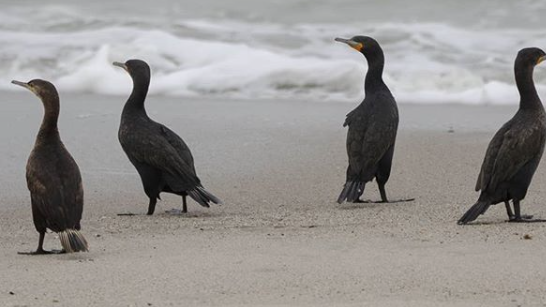Every so often, flocks of slender black birds can be seen crowding Milnerton Beach before flying off. Residents in the area have long wondered about the habits of these little birds, and what exactly they are.
According to the Two Oceans Aquarium, these birds are Cape cormorants.
The Cape cormorant is the most abundant seabird in the region, and is characterised by its black feathers with an orange-yellow gape of the bill and a turquoise eye.
“The Cape Cormorant breeds at 69 different sites between Namibia and the Eastern Cape Province, although it does range as far north as Lobito, Angola during the winter months,” said the Two Oceans Aquarium. “Cape Cormorants regularly undertake migrations up the east coast of South Africa, following the annual sardine run. The southern African population of Cape Cormorants has declined from more than a million birds in the early 1970s to about 120 000 pairs in the mid-1980s.”
Cormorants dive underwater to catch food, and have feathers that are easily waterlogged. This is one reason you often see cormorants standing with their wings spread, drying their wet wings after diving.
Cape cormorants are known to feed on large surface shoals of fish, and feed in flocks that often make up thousands of birds. Their tendency to fly in long lines or V-shaped flocks resulted in their Afrikaans name of ‘trekduiker’.
“Pilchards were once the main source of food for Cape Cormorants, but since the decline in pilchard stocks, anchovies have become their staple diet. Anchovy resources are heavily fished and, as a result, Cape Cormorants are vulnerable to temporary and local shortages of food,” it added.
The breeding period is from September to February in SA. It is a monogamous colonial nester, living in large, tightly packed colonies. The nests are made from seaweed and sticks. The female lays two to three chalky-white eggs.
Single birds and flocks prefer coastal waters. They roost on offshore islands.
In South Africa, the Cape cormorant is a winter visitor to the KwaZulu-Natal coast. It is an endemic resident along the entire south-western Cape coast and up to 50 km out to sea.
Cormorants are also popular in many myths and superstitions, these include the following:
– In the Greek tale of Ulysses, after a storm broke the mast of Ulysses’ raft, a sea nymph disguised herself as a cormorant and handed Ulysses a girdle to keep him afloat while he swam to shore.
– In Norwegian myths and folklore, three cormorants flying together are said to be carrying messages and warnings from the dead. In northern Norway, cormorants are considered to be good luck when they gather in a village. Norwegian myth also states that people who die at sea can visit their former homes in the form of a cormorant.
– In Polynesian mythology, Maru-tuahu used feathers to make himself “as handsome as the crested cormorant” when both young daughters of Te Whatu declared their desires to marry him.
– In Ireland and some other places, seeing a cormorant perched atop a church steeple is a warning of bad luck to come.
– In England, the mythical “Liver Bird,” the symbol of the city of Liverpool, is thought to be a cross between a cormorant and an eagle.
Picture: @africabirdy/Twitter

